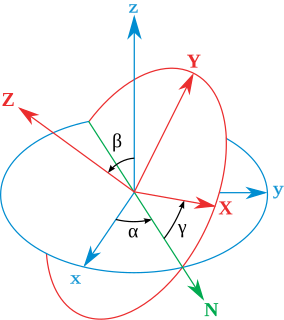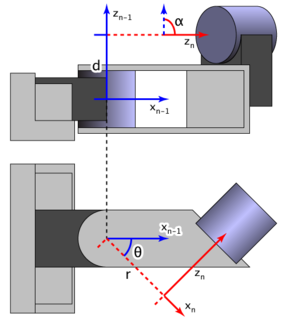Kinematics is a subfield of physics, developed in classical mechanics, that describes the motion of points, bodies (objects), and systems of bodies without considering the forces that cause them to move. Kinematics, as a field of study, is often referred to as the "geometry of motion" and is occasionally seen as a branch of mathematics. A kinematics problem begins by describing the geometry of the system and declaring the initial conditions of any known values of position, velocity and/or acceleration of points within the system. Then, using arguments from geometry, the position, velocity and acceleration of any unknown parts of the system can be determined. The study of how forces act on bodies falls within kinetics, not kinematics. For further details, see analytical dynamics.

An industrial robot is a robot system used for manufacturing. Industrial robots are automated, programmable and capable of movement on three or more axes.
In mathematics and computer science in general, a fixed point of a function is a value that is mapped to itself by the function.
In computability theory, a set S of natural numbers is called computably enumerable (c.e.), recursively enumerable (r.e.), semidecidable, partially decidable, listable, provable or Turing-recognizable if:

R is a programming language for statistical computing and graphics supported by the R Core Team and the R Foundation for Statistical Computing. Created by statisticians Ross Ihaka and Robert Gentleman, R is used among data miners and statisticians for data analysis and developing statistical software. Users have created packages to augment the functions of the R language.

The Euler angles are three angles introduced by Leonhard Euler to describe the orientation of a rigid body with respect to a fixed coordinate system.
In computer science, a record is a basic data structure. Records in a database or spreadsheet are usually called "rows".
A nonholonomic system in physics and mathematics is a physical system whose state depends on the path taken in order to achieve it. Such a system is described by a set of parameters subject to differential constraints, such that when the system evolves along a path in its parameter space but finally returns to the original set of parameter values at the start of the path, the system itself may not have returned to its original state.
A datum reference or just datum is some important part of an object—such as a point, line, plane, hole, set of holes, or pair of surfaces—that serves as a reference in defining the geometry of the object and (often) in measuring aspects of the actual geometry to assess how closely they match with the nominal value, which may be an ideal, standard, average, or desired value. For example, on a car's wheel, the lug nut holes define a bolt circle that is a datum from which the location of the rim can be defined and measured. This matters because the hub and rim need to be concentric to within close limits. The concept of datums is used in many fields, including carpentry, metalworking, needlework, geometric dimensioning and tolerancing (GD&T), aviation, surveying, and others.
The Glyph Bitmap Distribution Format (BDF) by Adobe is a file format for storing bitmap fonts. The content takes the form of a text file intended to be human- and computer-readable. BDF is typically used in Unix X Window environments. It has largely been replaced by the PCF font format which is somewhat more efficient, and by scalable fonts such as OpenType and TrueType fonts.
In the Java programming language, the final keyword is used in several contexts to define an entity that can only be assigned once.

SystemVerilog, standardized as IEEE 1800, is a hardware description and hardware verification language used to model, design, simulate, test and implement electronic systems. SystemVerilog is based on Verilog and some extensions, and since 2008 Verilog is now part of the same IEEE standard. It is commonly used in the semiconductor and electronic design industry as an evolution of Verilog.
Glossary of Unified Modeling Language (UML) terms provides a compilation of terminology used in all versions of UML, along with their definitions. Any notable distinctions that may exist between versions are noted with the individual entry it applies to.
A Windows Script File (WSF) is a file type used by the Microsoft Windows Script Host. It allows mixing the scripting languages JScript and VBScript within a single file, or other scripting languages such as Perl, Object REXX, Python, or Kixtart if installed by the user. These types of scripts may also be used to link many other external scripts together using a src parameter on the <script> tag in a manner similar to HTML. Windows Script Files have the extension ".WSF". A WSF makes reference to each script module in a very basic XML hierarchy as shown below, adhering to those standards outside the <script> tags. Literal use of "</script>" or "<script>" inside your <script> tags and similar challenges can be handled by the use of CDATA, as shown within the examples.
In geometry, various formalisms exist to express a rotation in three dimensions as a mathematical transformation. In physics, this concept is applied to classical mechanics where rotational kinematics is the science of quantitative description of a purely rotational motion. The orientation of an object at a given instant is described with the same tools, as it is defined as an imaginary rotation from a reference placement in space, rather than an actually observed rotation from a previous placement in space.

In mechanical engineering, the Denavit–Hartenberg parameters are the four parameters associated with a particular convention for attaching reference frames to the links of a spatial kinematic chain, or robot manipulator.
The direct-quadrature-zerotransformation or zero-direct-quadraturetransformation is a tensor that rotates the reference frame of a three-element vector or a three-by-three element matrix in an effort to simplify analysis. The DQZ transform is the product of the Clarke transform and the Park transform, first proposed in 1929 by Robert H. Park.
Pic Micro Pascala.k.a. PMP is a free Pascal cross compiler for PIC microcontrollers. It is intended to work with the Microchip Technology MPLAB suite installed; it has its own IDE (Scintilla-based) and it is a highly optimized compiler.
In physics and engineering, Davenport chained rotations are three chained intrinsic rotations about body-fixed specific axes. Euler rotations and Tait–Bryan rotations are particular cases of the Davenport general rotation decomposition. The angles of rotation are called Davenport angles because the general problem of decomposing a rotation in a sequence of three was studied first by Paul B. Davenport.






